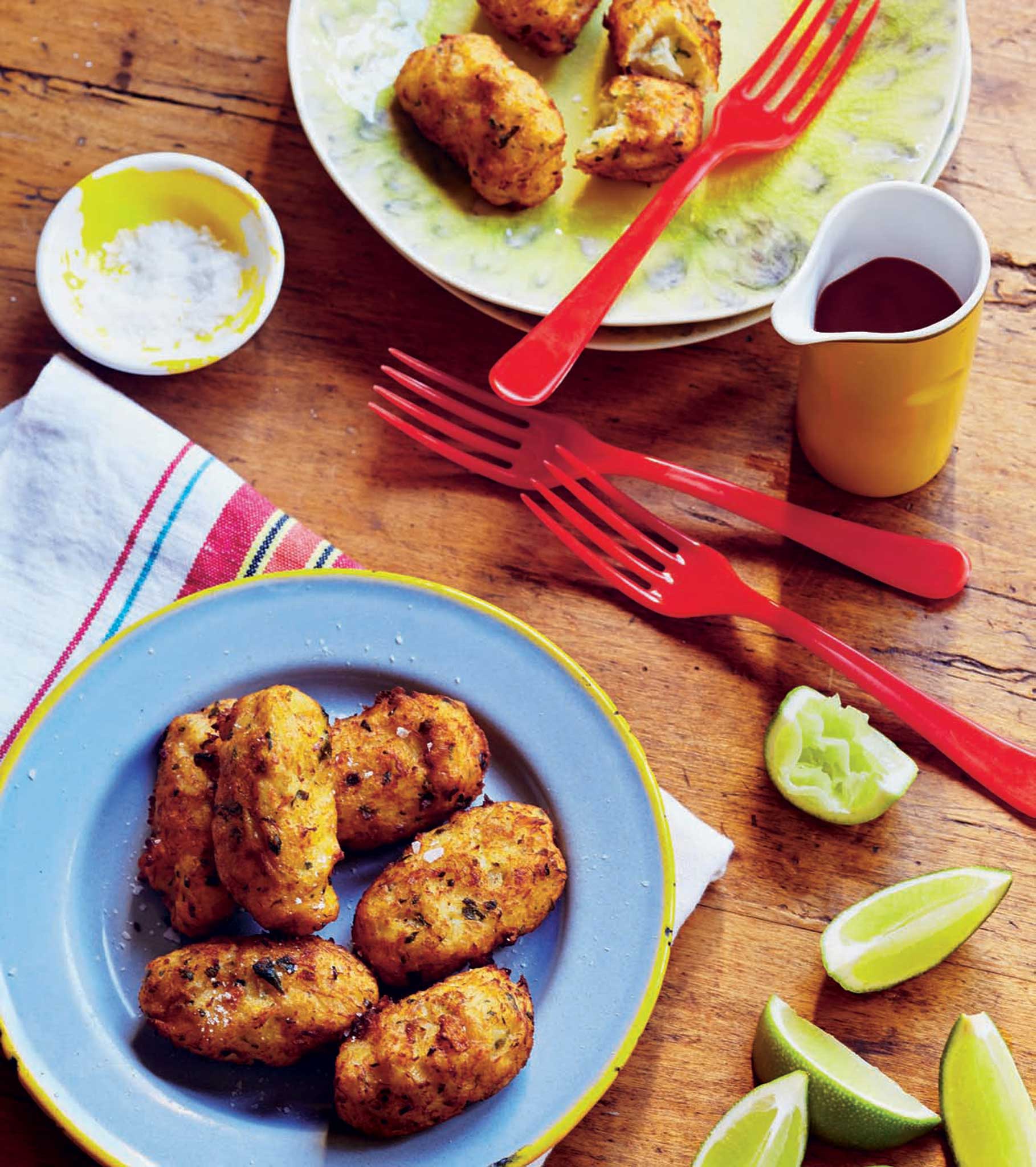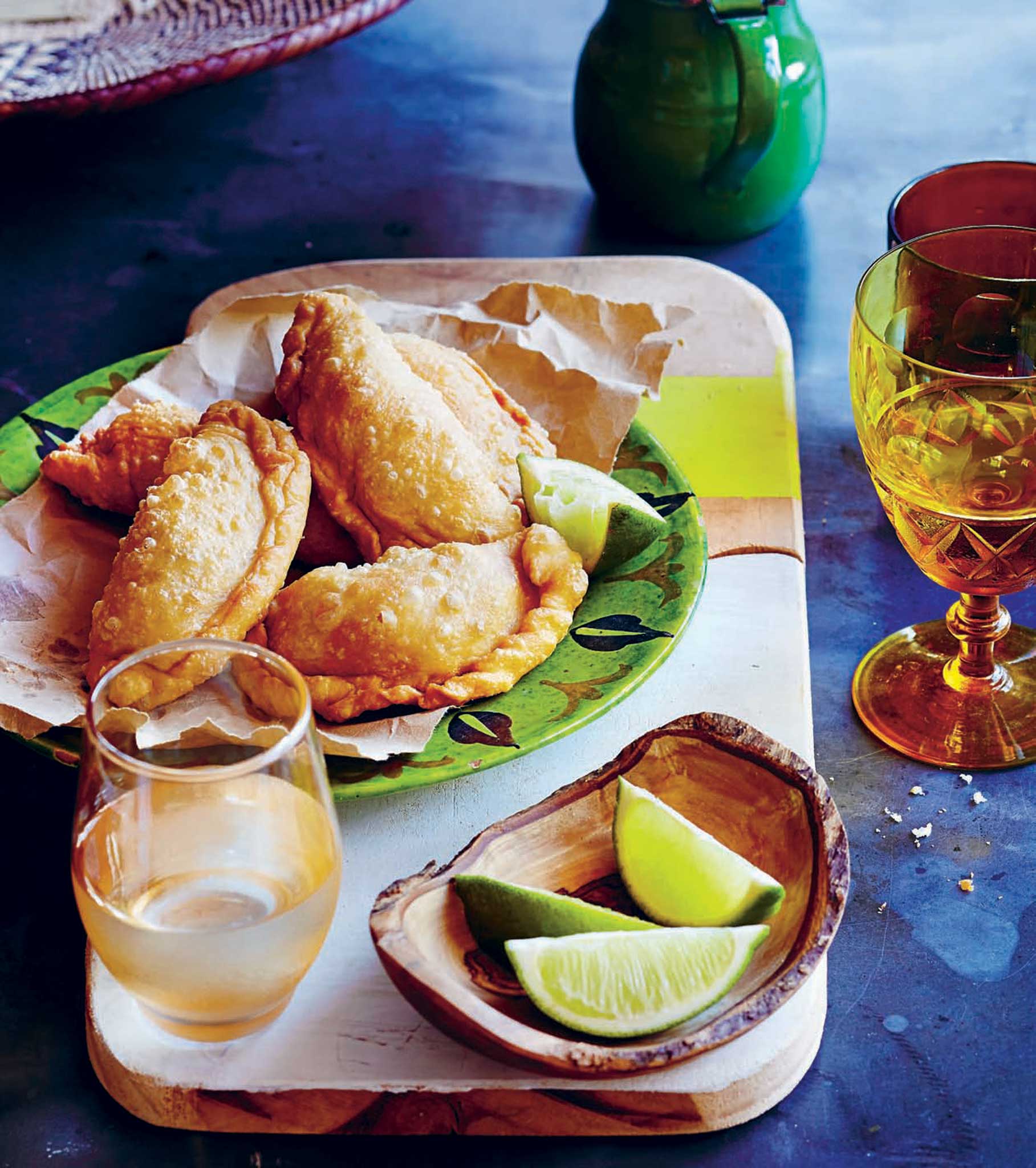World Cup 2014: Give pies and pints the red card and get into the Brazilian party spirit with authentic half-time tongue-ticklers
From salty cod fritters and deep-fried prawn pastries to crispy cassava chips and taro leaf fritters, 'This is Brazil' authors Fernanda de Paula and Shelley Hepworth share their favourite Brazilian bar snacks

Your support helps us to tell the story
From reproductive rights to climate change to Big Tech, The Independent is on the ground when the story is developing. Whether it's investigating the financials of Elon Musk's pro-Trump PAC or producing our latest documentary, 'The A Word', which shines a light on the American women fighting for reproductive rights, we know how important it is to parse out the facts from the messaging.
At such a critical moment in US history, we need reporters on the ground. Your donation allows us to keep sending journalists to speak to both sides of the story.
The Independent is trusted by Americans across the entire political spectrum. And unlike many other quality news outlets, we choose not to lock Americans out of our reporting and analysis with paywalls. We believe quality journalism should be available to everyone, paid for by those who can afford it.
Your support makes all the difference.Brazil is a country with partying in its veins. The upcoming World Cup will give the country the opportunity to do what it does best: throw a giant celebration. For Brazilians, that means good company, good music and, of course, good food.
When the Seleção (the national team) is playing, the entire country stops to watch; some will do so at home, surrounded by family and friends, but still more will head to the numerous botecos (small bars) which you find all across the country.
In the cities hosting World Cup games, these bars will offer crunchy pastels, salty cod fritters and crispy cassava chips, accompanied by ice-cold beer and lots of caipirinhas. Declared the 'national cocktail' in a 2003 presidential decree, caipirinha is made of cachaça – a uniquely Brazilian spirit liquor derived from fermented sugar cane – and is the perfect accompaniment to these deep-fried treats (see the link to our step-by-step guide to making them at home below).
Just remember, though, while food and music will be the focus of things before and after the match, during half-time and long into the night after it has finished, when the players are on the field, the event has something of the sacred about it; so, if you do try to start a conversation while the ball is still in play, you're at risk of being punched on the nose, even if you were only offering one of the delicious snacks whose recipes you will find below.
'This is Brazil' by Fernanda de Paula and Shelley Hepworth is out now (£16.99, Hardie Grant). Their TV series, 'This is Brazil', airs on UK Travel Channel on 7 June
From Bruno Da Motta
Makes 15-20
Bolinho de bacalhau are a national favourite and can be found at bars and street stalls all over the country. They are ideal for making in advance and freezing.
300g dried salt cod
1 lime, sliced
1ltr vegetable stock
Dash of white wine
500g all-purpose potatoes, roughly chopped
2tbsp olive oil
½ onion, diced
1 egg, separated
2tbsp chopped fresh coriander leaves
Pinch of salt
1tbsp plain (all-purpose) flour, this is optional
Oil for deep frying
Lime wedges to serve
Soak the cod in cold water overnight, changing the water at least once.
Preheat the oven to 180C. Put the drained cod in a roasting tin and cover with the lime slices. Pour in the stock and white wine. Poach the cod in the oven for 20 minutes. Leave to cool, then gently peel off the skin from the cod and break the flesh in half, removing the spine. Shred the cod with your fingers, removing any bones.
Meanwhile, boil the potatoes until soft, then drain well and mash.
Heat the olive oil in a small frying pan and sauté the onion over a medium heat for 3 minutes, or until just tender.
Combine the cod with the potatoes, onion, egg yolk and coriander. Whisk the egg white in a small bowl, then add it to the cod mixture along with the salt.
Use your hands to combine the mixture. Add the flour, if needed, to help the mixture hold its shape. Shape the mixture into balls or croquettes and refrigerate for 15-20 minutes.
Heat 2.5cm of oil in a deep, heavy-based frying pan or saucepan to 180C, or until a cube of bread dropped into the oil turns golden brown in 15 seconds. Cook the fritters in batches for 3-4 minutes per batch, or until golden brown. Remove the fritters using a slotted spoon and drain on a paper towel. Serve the fritters with lime wedges.
Notes: If you don't have time to change the soaking water, you can soak the cod in milk for the same result. Try adding a cube of mozzarella to the middle of the fritters for a cheesy surprise.
Pastel de Camarao (deep-fried prawn pastries)
Makes about 30
Pastels are served everywhere in Brazil – on the beach, at markets or at house parties.
They come with all kinds of fillings: prawn, beef, ham and cheese, plain cheese, cheese and banana.
This recipe is for prawn pastels, but you can fill them with whatever you like.
Make them small for canapés or slightly larger to serve with a salad for lunch or dinner.

750g raw prawns
2 garlic cloves, crushed
3-4 bird's eye chillies, finely chopped
2tbsp olive oil
¼ onion, diced
3 tomatoes, peeled, seeded and finely chopped
250ml tomato passata (puréed tomatoes)
2tbsp finely-chopped coriander (cilantro) leaves
2tbsp tomato sauce (ketchup)
Oil for deep frying
Lime wedges to serve
For the vinaigrette
¼ yellow capsicum (bell peppers), finely chopped
¼ green capsicum, finely chopped
¼ red capsicum, finely chopped
¼ onion, diced
1 tomato, diced
2tbsp red wine vinegar
2tbsp olive oil
Pinch of salt
For the garlic paste
1tsp crushed garlic
1tsp finely-chopped parsley
1tsp olive oil
For the dough
1kg plain (all-purpose) flour, plus extra, for rolling
1tbsp sea salt
250ml rapeseed/vegetable oil
2tbsp cachaça
To make the vinaigrette, combine the capsicums, onion, tomato, vinegar, oil and salt in a bowl. Leave to marinate in the refrigerator overnight.
Peel and devein the prawns, then combine them with the garlic and 1tsp of the chilli. Leave to marinate in the refrigerator for a couple of hours.
To make the garlic paste, use a mortar and pestle to blend the garlic, parsley and oil until a smooth paste is formed.
To make the dough, put the flour in a large bowl and make a well in the middle. Add the salt, oil, cachaça and 500ml warm water, and mix until combined. Firmly knead the dough for 5-10 minutes, or until the dough has an elastic texture. Rest the dough for at least 30 minutes.
Heat the olive oil in a saucepan and cook the onion over a medium heat for 4 minutes, or until it begins to caramelise. Add the garlic paste and remaining chilli. Cook, stirring, for 1-2 minutes. Stir in the chopped tomatoes and sauté for a few minutes to allow the flavours to combine. Stir in the marinated prawns and the passata. Cook for 2-3 minutes, or until the prawns are almost cooked through. Stir in the coriander, tomato sauce and vinaigrette, and season.
Divide the dough into 30 equal portions, then roll each portion into a 12cm round, sprinkling the dough with flour as you roll to prevent sticking.
Spoon a small portion of the filling into the middle of each dough circle. Use the back of a fork to fold over the dough, creating a half-moon shape, and lightly flatten. Crimp the edges of the dough together.
Heat 2.5cm of oil in a deep, heavy-based frying pan or saucepan to 180C, or until a cube of bread dropped into the oil turns golden brown in 15 seconds.
Cook the pastries in batches for 4 minutes per batch, or until they are golden brown. Remove the pastries using a slotted spoon and drain on a paper towel. Serve the pastries with lime wedges.
Note: The cachaça creates bubbles in the dough when it's fried, giving it a crunchy texture. You can use vodka or white vinegar instead of cachaça.
Mandioca frita (Fried cassava chips)
Serves 4-6
This typical boteco food is easy to make and seriously delicious to eat. The chips go very well with a cold beer.
1kg cassava, peeled
Salt
Rice or sunflower oil, for deep frying
Add the cassava pieces to a large saucepan and season. Cover with water and bring to the boil. Reduce the heat and simmer for 10 minutes, or until the cassava pieces are soft when tested with a fork. Drain the cassava and leave to cool.
Pour enough oil into a deep, heavy-based frying pan or saucepan to cover the cassava pieces. Heat the oil to 200C, or until a cube of bread dropped into the oil turns golden brown in 10 seconds.
Carefully add the cassava pieces to the hot oil in batches, leaving at least 2cm between the pieces.
Cook for 8-10 minutes per batch, or until crisp.
Remove the cassava chips using a slotted spoon and drain on a paper towel. Sprinkle with salt, and serve immediately.
Bolinho de taioba (taro leaf fritters)
Makes about 16
If you can't get Taro leaves, use kale.
300g taro leaves or kale, stalks trimmed
2½tbsp olive oil
2 garlic cloves
3 eggs, lightly beaten
100g grated Parmesan
185g plain (all-purpose) flour
2tsp baking powder
Sea salt
Oil for deep frying
Heat the olive oil in a large saucepan over a medium heat. Add the garlic cloves and taro leaves, cover and cook, stirring occasionally, for 5-6 minutes, or until the taro leaves have softened.
Transfer the mixture to a large bowl and let it cool slightly. Discard the garlic.
Add the eggs and Parmesan to the taro mixture and stir until well combined. Sift the flour and baking powder together, then stir into the taro mixture to form a soft dough. Season the dough with sea salt and freshly ground black pepper.
Heat the oil in a heavy saucepan to 180C or until a cube of bread dropped into the oil turns golden brown in 15 seconds.
Carefully drop heaped tablespoons of the dough into the hot oil and cook in batches, turning once, for 5-6 minutes per batch, or until deep golden and pulled.
Remove the fritters using a slotted spoon and drain on a paper towel. Serve hot.
Join our commenting forum
Join thought-provoking conversations, follow other Independent readers and see their replies
Comments